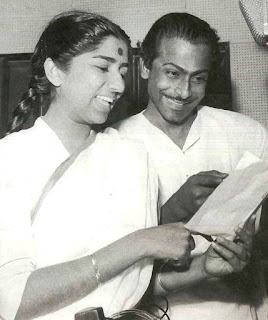As a Bengali, who has spent his childhood in the 1970-s, in a small industrial town of West Bengal, the occasion of Durga Puja was the single most important annual event of our lives… not least for the lovely new 'aadhunik' (non-film) songs that were released by HMV. While the affluent used to buy these records (typically 45 rpm vinyl-s), the ‘Puja–Pandal’-s used their public address system to play these songs for everyone to enjoy.
My very first memory of listening to a 'Puja-song' was in 1972. By then, Lata Mangeshkar’s ‘Pujo’ songs were already a rage, for well over a decade. Beautiful songs, composed by talents like Satinath Mukherjee, Bhupen Hazarika, Hemanta Mukherjee, Binod Chattopadhyay, Rahul Dev Burman and, most prominently, Salil Chowdhury, had already nestled into the hearts of Bengali-s since the mid/late 1950-s. Typically, the songs of the two sides of the 78 rpm or 45 rpm had contrasting tunes and moods that showcased the versatility of the singer. The people of Bengal were already in awe of Lata’s effortlessness across different genres & styles of songs.
As I walked into the large playground of our locality, (where the community Puja was being held), holding my parents' hands, the trendy strains of Salil Chowdhury’s ‘antabiheen… kaaTe naa aar jeno biroher-I ei din…’ caught my attention.
As the record was flipped to play the 2nd song, the dulcet tone of a sugary-sweet voice wafted into my ears & had a magnetic effect on me. Since then, the song, ‘kichhu to chaahini aami...', has remained safely tucked away in a very special nook of my senses. While ‘antabiheen…’, a compellingly riveting tune, caught my fancy, even at that tender age (and has remained a preferred song right till my college days), it is ‘kichhu to chaahini aami…’ that has made me subconsciously aware of the phenomenon that is Lata Mangeshkar.
There is something very Indian about her tone and something very un-Indian about her singing. Her tonal quality conjures images of a cultured and reserved Indian lady. Her singing, on the other hand, has a ruthlessness of perfection in it (albeit subdued). Something which one generally does not equate with a ‘vinamra bhaaratiya naari’. Singers like Zohrabai Agrewali or Kesarbai Kerkar, with a different social standing, are expected to be perfect in their ‘swar’ production... not a someone with a genteel ‘gayaki’ like Lata Mangeshkar.
It is this apparent dichotomy which, in my humble opinion, has made her such a formidable & compelling artist.
The skill with which she can un-throttle her vocal chords in the middle of a note to sound more luminous (by adding those extra harmonics), is a gift from the Almighty. Then, of course, her ability to nonchalantly slip in a beautiful yet under-stated embellishment/ornamentation (a 'murki') in a song.
She starts softly with the lines ‘kichhu to chaahini aami, shudhu cheye cheye thaaki…’
Then, as she sings ‘jodi kichhu bawlo…’ she increases the radiance of her voice, ever so slightly, to add extra harmonics to permeate into our senses.
And, finally, in the line ‘aami chhalo-chhalo chokhey…’, she softens her voice again but slips in a murki that is so incandescently beautiful that it lights up the atmosphere.
For me, just the four opening lines of this song encompass almost everything that Lata Mangeshkar’s singing means to me. The level of aesthetics that she could infuse into a melody betrays an extraordinary artistic mind... a gift from the Universe to her.
A term which often crosses my mind (for this special gayaki of hers)… caramelised sugar cubes dipped in honey.
This song, an evocative Salil-masterpiece, replete with wondrous piano-passages (and strings section), fits the bill. Even as a non Bengali, the artistic maturity with which she enunciates the lyrics, is brilliant.
No wonder that Salil Chowdhury (and several other composers) have gone on record to say that he could compose any tune with a relieved mind, knowing that virtually nothing was beyond the capabilities of this remarkable singer.
I remain ever so grateful for being able to savour these, first hand.
The song:
kichhu to chaahini aami - Bengali Non-Film (1972)
Music & Lyrics - Salil Chowdhury
antabiheen... - Bengali Non-Film (1972)
Music & Lyrics - Salil Chowdhury






